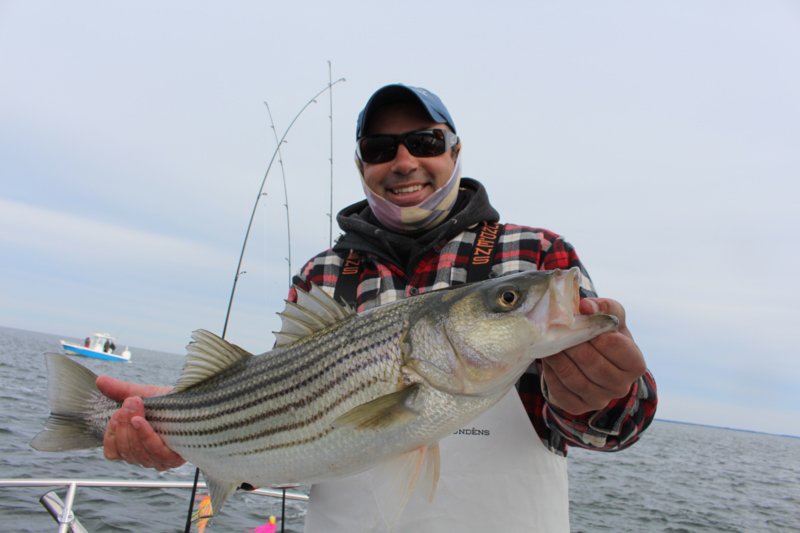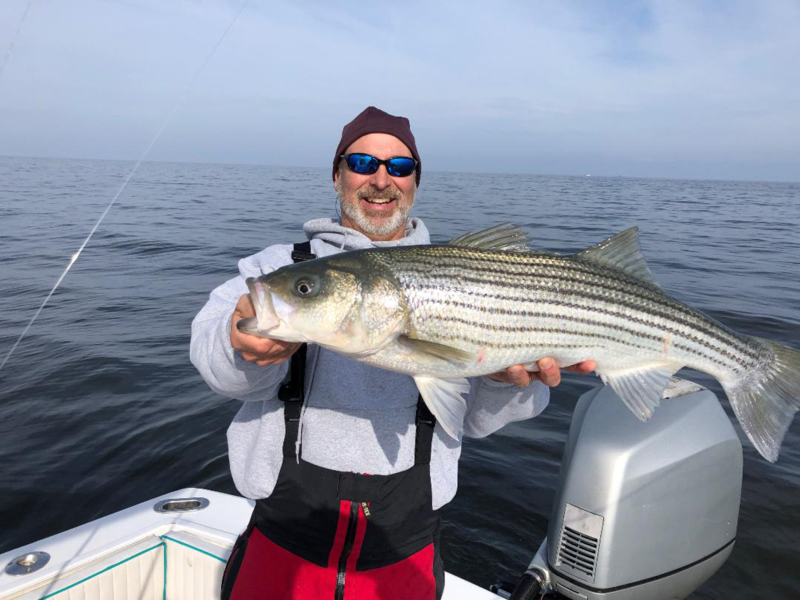By Thanksgiving Day most Chesapeake Bay anglers will winterize their boats, leaving them covered by shrink wrap. Outboards will be fogged, inboards will be drained, and rods and reels will be stowed in the basement. That’s a shame, because some of the best Chesapeake Bay fishing has to offer is yet to come. If you’re not quite ready to hang up the gear and call it quits for 2021, prepare to get in on this awesome late season fishery.

The Great Temptation of Point Lookout
We generally think of spring as the best time to catch large striped bass on the Bay, and that time of year certainly does provide the most consistent bite for fish over 35 inches. But those anglers who quit fishing for the season prior to the first snowfall may not realize that a good number of large stripers move into the Bay late in the late fall, as well. Whether they will stay here all winter or just move in for a quick bite can’t be predicted from year to year, but in either case, most years they can be targeted from around Thanksgiving through the month of December.
These are ocean-run fish, as evidenced by the sea lice you’ll find on them. Usually they average in the 30-plus-inch class, with 40-plus inch fish popping up with some regularity. Some seasons they tend to remain in Virginian waters, others they roam all the way up to Love Point and beyond. But from year to year, the most reliable port to fish from when targeting these late season stripers is probably Point Lookout.
On the Troll for Rockfish
A good area for trollers to search for these fish is just off to the east of Point Lookout. The channel runs deep here, nearing 100 feet in several areas, and provides an excellent shelf on the eastern edge. Many anglers will launch at Point Lookout, troll to the south/east until they cross the channel and this edge, then turn and follow the edge running north, zig-zagging from depths in the 30s to depths in the 60s or 70s. When they’ve traveled far enough north that they are in line with Point No Point to the west, they turn south and head back towards Point Lookout. Then, they head to the south-east again, completing this triangular trolling pattern. You’ll know that this is the tactic to try when you start hearing about channel markers 70 and 72 in the fishing reports; they’re often referenced in fishing reports and by word-of-mouth.
Trolling for these fish is a game surprisingly similar to spring trolling. You’ll want to pull umbrellas rigged with chartreuse, white, or pearl shad body teasers and parachutes or large bucktails for hook baits. Big Tony Accetta spoons (#19 or #21s) and tandem rigs will also catch fish. Some seasons hoses (red, green, or black; the hot colors will change depending on conditions) also catch a fair amount at this time of year. Swimming plugs such as Stretch 25s and daisy chains can also be effective at times and tend to be more popular in Virginian waters. If you’re a troller you probably have most or all of this gear already — hopefully not sitting in the basement waiting for spring.
When the fish travel farther to the north, the deepwater trolling game essentially remains the same: Troll in depths from 30’ or 35’ to 70’ or 80’, zig-zagging over the channel edges. And don’t think this can’t work as far north as the Bay Bridges and beyond. While it may not have been the norm the past few years, around a decade ago this zone held more trophy-sized Thanksgiving fish than any other area — season to season, all bets are off.
One note: at this time of year the fish will often be found hanging deeper, sometimes right down on the bottom. So when you troll for these late season fish, be sure to weight some rigs down and cover the entire water column.
Jigging for Late Season Stripers
Jiggers will commonly rely on their binoculars to find the fish. Working birds often give away their locations, and nothing — nothing — beats a pair of 14X or more powerful gyroscopic-stabilized binoculars for spotting them. As far as the Point Lookout area goes, when the birds aren’t cooperative, the stripers can often be found on the meter by hunting the lumps and ridges in 25 to 35 feet of water just north-east of the point and almost dead west of Tanner Creek. Searching the edges in this same depth range and slightly deeper inside the river’s mouth and on the north side of Smith Point can be highly productive as well.
But — and this is a big but — most of the time you encounter birds and breaking fish at this time of year, the fish right on the surface will be on the smaller side of the range. Twenty-something-inchers up into the low- to mid-30s will bust water, but rockfish beyond that size will usually (though not always!) be found down deep under the frenzy. To target them you’ll want to toss your jig to the outer edges of the visible action, let it sink 35 or 40 feet down (or to the bottom, whichever comes first), then begin a snap-jigging-style retrieve with a slightly slower cadence and more sink-time than you’d allow during the summer months when the fish’s metabolism is in a higher gear.

Standard heads and plastics work great for this game, but to hit these depths you’ll want to upsize your heads. One ounce is often too light, one and a half is usually a good pick, and two ounces isn’t always out of line. Also note that adding skirts can be a big deal at this time of year and a color-contrasting chartreuse/white tail/skirt combination is almost always a good starting point.
When the big fish are hovering under a school in very deep, open water, you’ll want to ID their depth, get your jig down to them, and just about bop them on the head with it. That sounds easier said than done, but you can make it simpler to accomplish by switching over to a jigging spoon. These lead chunks show up well on quality modern fish finders, and you can often position yourself on the boat so that your spoon is dangling beneath the transducer. Then you can spot the lure on-screen, thereby pinpointing its depth and allowing you to keep it right in the strike zone.
Of course, it can be uncomfortable to try to keep your lure right under the boat and your line may be danger-close to the prop. No problem. Once you have the spoon in position you can crank the lure up, and count how many revolutions of the reel it takes. Then move to a proper area of the boat to jig from, click your reel’s anti-reverse button, and crank slowly backwards for the exact same number of revolutions. Now go back to your meter and watch it; if good marks continue to show up at the same depth you know you’re in the zone. If not, drop or raise the spoon accordingly, and jig away.
Going beyond the PLO zone, again, all bets are off from season to season. That said, these fish have been known to show up in just about all the usual hotspots clear up to Love Point, so keep your eyes on the weekly fishing reports. Warm water discharges like the Calvert Cliffs Nuclear Power Plant (CCNPP) also offers some possibilities, though most seasons the big fish don’t show up there until even later in the winter. That’s the spot to check out when you have to break ice at the launch ramp in order to put your boat in the water.
No matter how you target these late season stripers, getting them into your sights can extend your fishing season right into the winter months. Sure, the wind often blows, your hot coffee quickly turns into iced coffee, and you may have to brush some snow off the windshield. But it’s all well worth it to extend your fishing season with trophy-sized fish. And for that, we can all give thanks.